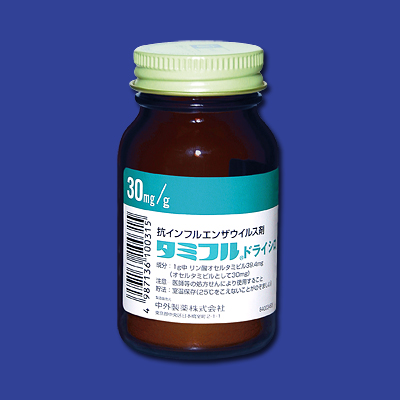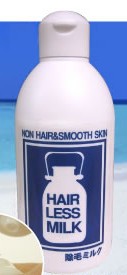In direct contrast to earlier posting, Tamiflu caught again the public attention - this time for far from envious reason.
Two recent incidents - juvenile suicides without any underlying social cause, were widely published in Japan, including extensive coverage in two consecutive nights on February 26 and 27, 2007 by the national TV broadcaster NHK. Undoubtedly, the interviews with broken relatives of the young victims should increase the public awareness and hence to make parents closely monitoring the treated children. Yet, the science behind the frightening cases in Japan is not revealed.
The holder of the Manufacturing and Sale Approval for Tamiflu in Japan is Chugai Seiyaku of the Roche group. The product was approved in two formulations in 2002, sold since then to millions and stocked for tens of millions.  The world supply of Tamiflu is not unlimited, as Japan also uses the majority of the world’s Tamiflu supply for seasonal flu. Japan has used 24 million prescriptions - ca. four times more than the US. World-wide, since Tamiflu was first approved in 1999, 12 children under 16 years of age and taking the drug have died, and 32 have suffered “neuropsychiatric events” such as hallucinations, confusion, convulsions and brain inflammation. All the deaths and the vast majority of adverse events in children, also including skin rashes and sensitivity, have been reported in Japan, where Tamiflu has been most widely prescribed. For the fiscal 2006 year, the MHLW received 12.8 billion Yen in supplementary budget as 8 billions of which to be spent for Tamiflu (90%) and Relenza (10%).
The world supply of Tamiflu is not unlimited, as Japan also uses the majority of the world’s Tamiflu supply for seasonal flu. Japan has used 24 million prescriptions - ca. four times more than the US. World-wide, since Tamiflu was first approved in 1999, 12 children under 16 years of age and taking the drug have died, and 32 have suffered “neuropsychiatric events” such as hallucinations, confusion, convulsions and brain inflammation. All the deaths and the vast majority of adverse events in children, also including skin rashes and sensitivity, have been reported in Japan, where Tamiflu has been most widely prescribed. For the fiscal 2006 year, the MHLW received 12.8 billion Yen in supplementary budget as 8 billions of which to be spent for Tamiflu (90%) and Relenza (10%).
Back in 2005, both FDA and EMEA held discussions to analyze the frightening side events observed in Japanese children, but concluded that the “increased reports of neuropsychiatric events in Japanese children are most likely related to an increased awareness of influenza-associated encephalopathy”, increased use of Tamiflu in Japan, and greater monitoring of adverse events.
Certainly, the voices that the exacerbated reactions to Tamiflu among Japanese pediatric patients may be related to ethic (pharmacogenomics?) cause are being heard, but still the overprescription theory rules.
Jouhoublog is a joint blog - post or send comments to ![]() .
.
Technorati Tags: MHLW; Japanese regulatory affairs
A research team of the ministry carried out a survey covering about 2,800 people in Japan last November and said it found no evidence of a relationship between the drug and abnormal behavior. There was no such behavior among 54 Tamiflu-taking patients who had died as of the end of January this year since marketing of the drug began in February 2001, the ministry said.
Tamiflu is produced by Switzerland’s Roche healthcare group and imported by Chugai Pharmaceutical Co. of Tokyo. The drug, also known as oseltamivir phosphate, will curb the growth of A- and B-type flu viruses, and if taken within 48 hours of the start of symptoms, fever will go down and recovery is said to be a day earlier than other drugs. In May 2004, Chugai added “consciousness disorders and abnormal behaviors” to a column of side effects in an appended paper attached to Tamiflu, but the company said it is a precautionary measure. At this stage, there is no need to single out the possibility of abnormal behaviors,” a ministry official said. But Rokuro Hama, head of the Japan Institute of Pharmacovigilance in Osaka, said, “There is a problem in the research team’s data. As far as behaviors immediately after taking the drug are concerned, the ratio of exhibiting abnormal behavior is four times greater” than publicly reported.
The ministry team is now carrying out a fresh survey covering 10,000 people with the aim of completing the results by fall. “We really need to establish whether there is any causal relationship with Tamiflu,” said chief researcher Shumpei Yokota, a professor in the graduate school of Yokohama City University. Takashi Arai, 50, a resident of the city of Kyoto and a member of the group of victims, visited a ministry official last week and said, “In prescribing drugs, some doctors carefully explain but some others just ask if drugs are taken or not.” In 2005, Arai’s son, who was in junior high school at the time, temporarily became violent after taking Tamiflu. Arai wants doctors, medical facilities and institutions to provide full information on possible side effects of Tamiflu to patients before they take the drug. The government is currently building a stockpile of the drug as part of its preparedness against an epidemic of a new form of flu.
Quote from Kyodo News, Feb 28, 2007
Jouhoublog is a joint blog - post or send comments to ![]() .
.
Technorati Tags: MHLW; Japanese regulatory affairs
Web site to offer information on drug side effectsThe Pharmaceutical and Medical Devices Agency on Tuesday launched a Web site that enables people to search for lists of side effects, symptoms and associated diseases brought on by a variety of medicines. The site, www.info.pmda.go.jp, includes a database of all side effects as reported by drug manufacturers. The first data to be made public by the agency was in April 2004, with accounts detailing 732 medicinal products and 2,477 related case studies that include information such as age, gender, disease, details of the side effects, the drug and other medicines taken concurrently. The site also includes case studies for the 63 people whose deaths during that period were brought on by side effects from medicines they were taking. Twelve of these deaths were linked to the lung cancer drug gefitinib, marketed as Iressa. Warnings also are included for cases in which the side effects were found to not be connected to health problems. The PMDA will make information from May 2004 onward available in due course, aiming to put a system into effect before the end of March 2008, with updates every six months. Until now, such reports were limited to cases involving previously unknown side effects, or where revisions had been made to warnings over usage. The new system was conceived of in the face of increasing complaints from citizens’ groups and others organizations demanding all the information be made public, as only 1,872 of the 25,000 or so drug-related side effects last fiscal year had been disclosed. The agency, an independent organization, has also begun posting on its Web site easy-to-understand explanations on dosage and side effects. Beginning with 54 kinds of drugs, including oral diabetes medication, the next medicines to be posted will include antirheumatic and antiasthmatic drugs. (The Daily Yomiuri, February 9, 2006, p. 3)
Femara - an aromatase inhibitor - is known to be submitted and currently under a review by the Japanese regulatory authorities. Yet, as distributed today by the mass media, the warnings issued by Novartis AG were forwarded to the physicians in Japan as well. As read between the lines - under the provision of the Pharmaceutical Affairs Law (PAL), any unapproved drug could be imported for individual use in Japan as long as the custom official is shown a prescription by Japanese doctor. Obviously, Femara (the name is misspelled in the original news release below) - another of the unapproved anti-cancer drugs in Japan has been imported by significant number of female patients treated domestically.
Jouhoublog is a joint blog - post or send comments to ![]() .
.
Technorati Tags: MHLW; Japanese regulatory affairs
TOKYO — A Swiss pharmaceutical company has decided to warn gynecologists in the United States, Japan and other countries not to prescribe women a breast cancer drug during pregnancy or before menopause, as it may harm unborn children, officials of the its Japanese associate said Wednesday.
In Japan the Pharmaceutical Affairs Law (PAL) permits individual import of both approved and unapproved drugs, as long as you have a prescription from Japanese physician.
Should we expect the Tamiflu to crash this winter the previous individual import record of Thalidomide (reportedly about 500,000 tablets were imported before the approval)?
Tamiflu is sold in Japan in two formulations: 75 mg capsules and 3% dry syrup, as the cost for 1-day treatment is 727.4 Yen for capsules and 1,392.5 Yen for the syrup.
Reported below in Yomiuri Shimbun:
Shortages push Tamiflu prices up 10-fold
Online purchases have depleted stocks. One agent offers 10 capsules of Tamiflu, or oseltamivir, imported from the United States for 30,000 yen, excluding shipping charges. "One U.S. company recently told us the price had risen to more than 300 dollars. We need to raise ours to 38,000 yen just to show a profit," the company’s president said. According to the company, which has acted as an import agent for six years, demand for Tamiflu remained low until last year when 10 capsules could be obtained for 8,000 yen. The government in 2001 designated the drug to be covered by national health insurance.
Purchase orders for Tamiflu surged early this month following an increase in news reports on the spread of a new type of influenza and the government’s announcement of its plan to further stockpile the flu-fighting drug. The company received orders for about 20 sets in the past week. Another agent, which offers Tamiflu for 25,000 yen, said it was out of stock and had a waiting list of about 100 people.
Chugai Pharmaceutical Co., which imports and markets Tamiflu, prices the drug at 363.7 yen per capsule. A dosage of two capsules a day is normally recommended for five days, and a set of 10 capsules is offered at 3,637 yen. Insurance coverage reduces the price to about 1,100 yen, but it requires a doctor’s prescription, which increases to the total cost to about 3,000 yen.
Jouhoublog is a joint blog - post or send comments to ![]() .
.
Technorati Tags: MHLW; Japanese regulatory affairs
We are receiving periodically inquiries regarding "quasi-drugs" in Japan, including about one recently mentioned. "Quasi-drugs" are the second category among all regulated medicinal products in Japan (along with drugs, medical devices and cosmetics).
It is not clear how and when the term emerged, however the origin could be traced to the first translations in 1980s of the Pharmaceutical Affairs Law (Law).
Current dictionaries only add to the confusion. English dictionaries define "quasi-" as resembling to some degree. On the other hand, the original Japanese term (iyaku gaibuhin) implies a drug used "outside" (i.e. not to be digested or injected). Bilingual (translation) dictionaries are even more helpless giving the meaning of iyaku gaibuhin as over-the-counter drug, unregulated drug (?!) and even the bizarre interpretation of AltaVista as "medicine public item".
Neither is correct. Quasi-drugs are regulated products, sold with no prescription and thus falling, although not filling up the OTC category. The category of quasi-drugs now covers much more types of products than the classical quasi-drugs (for foul body odor and breath control, hair removal, body pests extermination). The PAL in Article 2 defines quasi-drugs as not equipment or instruments and having no more than a mild effect on the human body.
The aromatic anti-Legionella cleanser for bathtubs may fit well into the definition, but how about the growing line of dietic products labeled as quasi-drugs?
Jouhoublog is a joint blog - post or send comments to ![]() .
.
Technorati Tags: MHLW; Japanese regulatory affairs
Recently, FDA updated the labeling of the three leading oral erectile dysfunction (ED) medications (Cialis, Levitra and Viagra) with a warning about the sudden vision loss, attributed to NAION (non arteritic ischemic optic neuropathy). While such updates are fairly common in the post-marketing period of any drug, in the case of Viagra it brought to the surface some information not very willingly disclosed by its maker. In the efforts to downplay the significance of NAION incidence, Pfizer reported that by mid-2005 a total of 27 million men have taken safely Viagra…
That’s it! For full seven years since the launch in 1998, Viagra has been used by only 1% of the world’s male population. Is this more, or less or in the range of what has been expected? Given the massive advertising campaign (over 100 million US$ in US alone), the unprecedented public interest and brand awareness, the common belief was - and likely still is, that Viagra is already taken virtually by everybody.
Jouhoublog is a joint blog - post or send comments to ![]() .
.
Technorati Tags: MHLW; Japanese regulatory affairs
One of the very prompt questions following the Eril mystique posting asked about www.eril.jp.
 Against all educated guesses, it turned out not to be a product site of Asahi Kasei. It is online shop of small distributor of cosmetics, dieting and beauty goods, doing business as "Eril" and on the top of its catalog under number Eril ck01 is a product named "Hairless Milk". Should we mention it here? Whatever hideous, the "Hairless Milk" is approved by MHLW in Japan as quasi-drug, otherwise there are no relations with cardiovascular Eril. But what about the 17-old trademark?
Against all educated guesses, it turned out not to be a product site of Asahi Kasei. It is online shop of small distributor of cosmetics, dieting and beauty goods, doing business as "Eril" and on the top of its catalog under number Eril ck01 is a product named "Hairless Milk". Should we mention it here? Whatever hideous, the "Hairless Milk" is approved by MHLW in Japan as quasi-drug, otherwise there are no relations with cardiovascular Eril. But what about the 17-old trademark?
Jouhoublog is a joint blog - post or send comments to ![]() .
.
Technorati Tags: MHLW; Japanese regulatory affairs
Since 2001 we have received dozens of inquires about Eril. Surprising is also the span of the inquirers – from US testing laboratories to product developers in EU to university researchers. Why Eril?
Eril (fasudil hydrochloride hydrate) was discovered by Asahi Kasei KK in 1980s. It is absolutely impossible to decipher the name of Eril, even knowing the typical for those years penchant for cryptic and “meaningful” abbreviations. The name of the pharmaceutical form Eril Inj. S stands for: Epoch-making relaxant for ischemic locality Injections Sun. Obviously afraid that somebody else might come with the same pearl, the maker registered Eril as a trademark  in 1988 – more than ten years before the approval and much earlier before the clinical trials ever began. The picture on the left is the actual image deposited to the Japan Patent Office.
in 1988 – more than ten years before the approval and much earlier before the clinical trials ever began. The picture on the left is the actual image deposited to the Japan Patent Office.
Eril is rarely advertized and for an epoch-making product sells somewhat weakly in Japan – chalking at average 10-12 millions US$ annually. But the inquiries keep coming…
Jouhoublog is a joint blog - post or send comments to ![]() .
.
Technorati Tags: MHLW; Japanese regulatory affairs